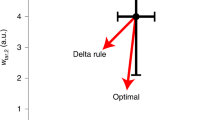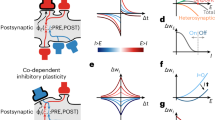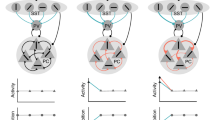Abstract
MOST theories of learning assume some change in the synaptic conductivity of cortical pathways1,2. Facilitation by use alone, however, will not account for the most characteristic feature of learning—that what is learned are those motor responses which lead to a satisfactory or adaptive state of affairs for the organism3–5.
This is a preview of subscription content, access via your institution
Access options
Subscribe to this journal
Receive 51 print issues and online access
$199.00 per year
only $3.90 per issue
Buy this article
- Purchase on Springer Link
- Instant access to full article PDF
Prices may be subject to local taxes which are calculated during checkout
Similar content being viewed by others
References
Kandel, E. R., and Spencer, W. A., Physiol. Rev., 48, 65 (1968).
Burns, B. D., The Uncertain Nervous System (Edward Arnold, London, 1968).
Thorndike, E. R., Animal Intelligence (Macmillan, New York, 1911).
Skinner, B. F., The Behaviour of Organisms (Appleton-Century-Crofts, New York, 1938).
Young, J. Z., A Model of the Brain (Oxford University Press, Oxford, 1964).
Beurle, R. L., Phil. Trans. Roy. Soc., B, 240, 55 (1957).
Beurle, R. L., in Principles of Self-Organization (Pergamon Press, Oxford, 1961).
Pringle, J. W. S., Behaviour, 3, 174 (1951).
Broadbent, D. E., Behaviour (Eyre and Spottiswoode, London, 1961).
Konorski, J., Conditioned Reflexes and Neuron Organisation (Cambridge University Press, London, 1948).
Hebb, D. O., The Organization of Behaviour (Wiley, New York, 1949).
Gerard, R. W., Amer. J. Psychiat., 106, 161 (1949).
Rusinov, V. S., Abstr. Nineteenth Intern. Physiol. Congr., Montreal (1953).
Morrell, F., Ann. NY Acad. Sci., 92, 860 (1961).
Anden, N. E., Dahlström, A., Fuxe, K., Larsson, K., Olson, L., and Ungerstedt, U., Acta Physiol. Scand., 67, 313 (1966).
Olds, J., and Milner, P. M., J. Comp. Physiol. Psychol., 47, 419 (1954).
Stein, L., Fed. Proc., 23, 836 (1964).
Schrödinger, E., Mind and Matter (Cambridge University Press, London, 1958).
Griffith, J. S., The Neural Basis of Conscious Decision (Bedford College, London, 1967).
Author information
Authors and Affiliations
Rights and permissions
About this article
Cite this article
CROW, T. Cortical Synapses and Reinforcement: a Hypothesis. Nature 219, 736–737 (1968). https://doi.org/10.1038/219736a0
Received:
Revised:
Issue Date:
DOI: https://doi.org/10.1038/219736a0
This article is cited by
-
Catalyzing next-generation Artificial Intelligence through NeuroAI
Nature Communications (2023)
-
Norepinephrine potentiates and serotonin depresses visual cortical responses by transforming eligibility traces
Nature Communications (2022)
-
Sensorimotor processing in the rodent barrel cortex
Nature Reviews Neuroscience (2019)
-
Diverse synaptic plasticity mechanisms orchestrated to form and retrieve memories in spiking neural networks
Nature Communications (2015)
-
New tricks and old spines
Nature (2009)
Comments
By submitting a comment you agree to abide by our Terms and Community Guidelines. If you find something abusive or that does not comply with our terms or guidelines please flag it as inappropriate.



